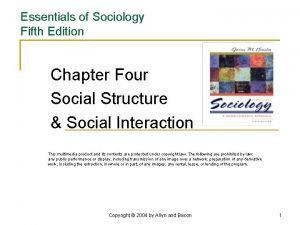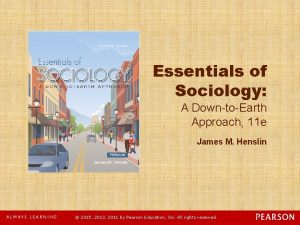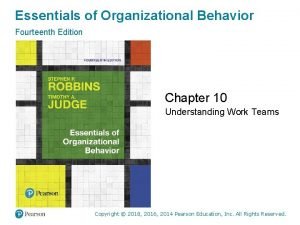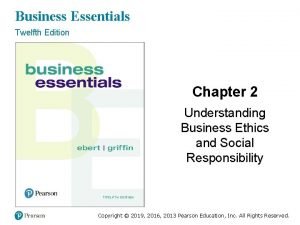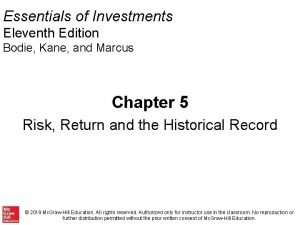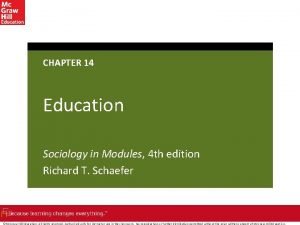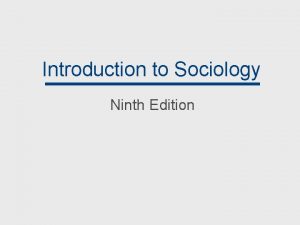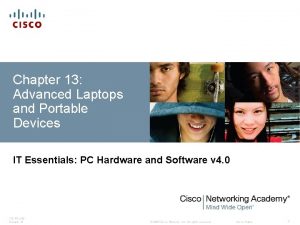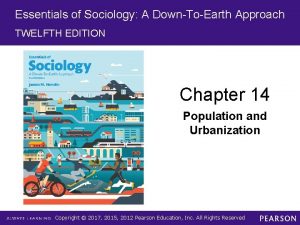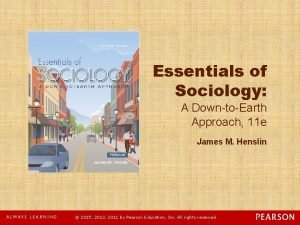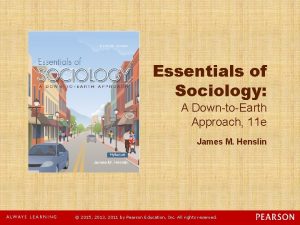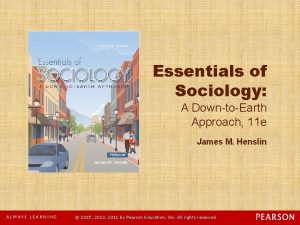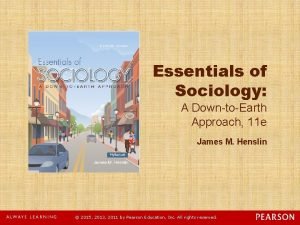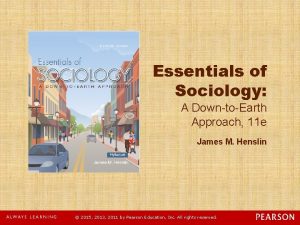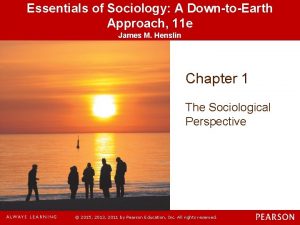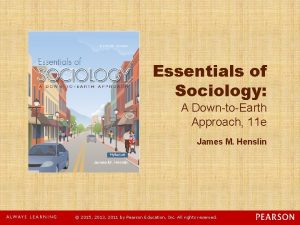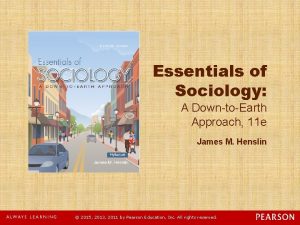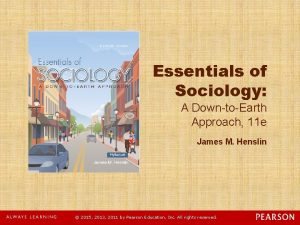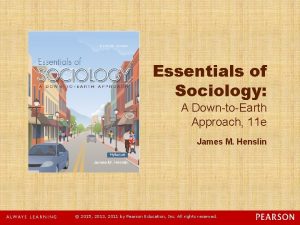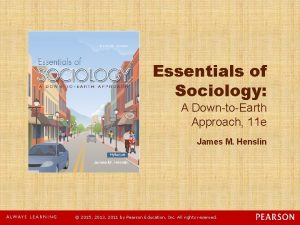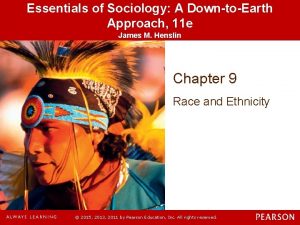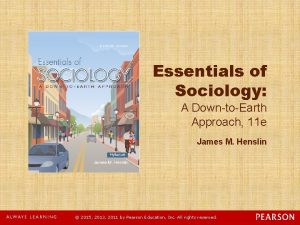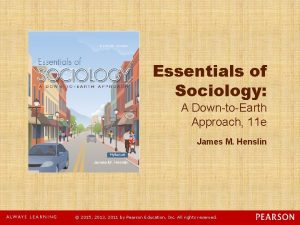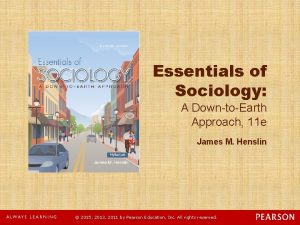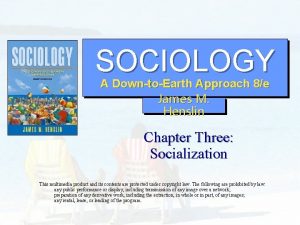Essentials of Sociology A DownToEarth Approach TWELFTH EDITION






















































- Slides: 54

Essentials of Sociology: A Down-To-Earth Approach TWELFTH EDITION Chapter 8 Social Class in the United States Copyright © 2017, 2015, 2012 Pearson Education, Inc. All Rights Reserved

Learning Objectives (1 of 3) 8. 1 Explain the three components of social class— property, power, and prestige; distinguish between wealth and income; explain how property and income are distributed; and describe the democratic façade, the power elite, and status inconsistency 8. 2 Contrast Marx’s and Weber’s models of social class Copyright © 2017, 2015, 2012 Pearson Education, Inc. All Rights Reserved

Learning Objectives (2 of 3) 8. 3 Summarize the consequences of social class for physical and mental health, family life, education, religion, politics, and the criminal justice system 8. 4 Contrast the three types of social mobility, and review gender issues in research on social mobility and why social mobility brings pain Copyright © 2017, 2015, 2012 Pearson Education, Inc. All Rights Reserved

Learning Objectives (3 of 3) 8. 5 Explain the problems in drawing the poverty line, how poverty is related to geography, race– ethnicity, education, feminization, age, and the culture of poverty; analyze why people are poor; and discuss deferred gratification and the Horatio Alger myth Copyright © 2017, 2015, 2012 Pearson Education, Inc. All Rights Reserved

LO 8. 1 What Is Social Class? • Property • Power • Prestige • Status Inconsistency Copyright © 2017, 2015, 2012 Pearson Education, Inc. All Rights Reserved

LO 8. 1—Property (1 of 2) • Slavery – – – Causes Conditions Bonded Labor Slavery in the New World Slavery Today Copyright © 2017, 2015, 2012 Pearson Education, Inc. All Rights Reserved

LO 8. 1—Property (2 of 2) A mere one-half percent of Americans owns over a quarter of the entire nation’s wealth. Very few minorities are numbered among this 0. 5 percent. An exception is Oprah Winfrey, who has had an ultrasuccessful career in entertainment and investing. Worth $2. 8 billion, she is the 215 th richest person in the United States. Winfrey has given millions of dollars to help minority children. Copyright © 2017, 2015, 2012 Pearson Education, Inc. All Rights Reserved

Figure 8. 1 Distribution of the Wealth of Americans SOURCE: By the author. Based on Wolff 2013. Copyright © 2017, 2015, 2012 Pearson Education, Inc. All Rights Reserved

Figure 8. 2 How the Income of Americans Is Distributed SOURCE: By the author. Based on Statistical Abstract of the United States 2014: Tables 709, 726. Copyright © 2017, 2015, 2012 Pearson Education, Inc. All Rights Reserved

Figure 8. 3 The More Things Change, the More They Stay the Same: Dividing the Nation’s Income SOURCE: By the author. Based on Statistical Abstract of the United States 1960: Table 417; 1970: Table 489; U. S. Census Bureau. Income, Poverty and Health Insurance Coverage in the United States: 2013. Historical Tables, Income, Households, Table H-2. 2014. Copyright © 2017, 2015, 2012 Pearson Education, Inc. All Rights Reserved

LO 8. 1—Power (1 of 2) • The Democratic Façade • The Power Elite Copyright © 2017, 2015, 2012 Pearson Education, Inc. All Rights Reserved

LO 8. 1—Power (2 of 2) Table 8. 1 The Five Highest-Paid CEOs CEO Company Compensation Michael Fries Liberty Global $112 Million Satya Nadella Microsoft $84 Million Oracle $67 Million Steven Mollenkopf Qualcomm $61 Million Leslie Moonves CBS $57 Million NOTE: Compensation is for 2014. It includes salary, bonuses, and stock options. SOURCE: Canipe and Slobin 2015. Copyright © 2017, 2015, 2012 Pearson Education, Inc. All Rights Reserved

LO 8. 1—Prestige (1 of 6) • Occupations and Prestige • Displaying Prestige Copyright © 2017, 2015, 2012 Pearson Education, Inc. All Rights Reserved

LO 8. 1—Prestige (2 of 6) Table 8. 2 Occupational Prestige: How the United States Compares with Sixty Countries Occupation United States Average of Sixty Countries Physician 86 78 Supreme Court judge 85 82 College president 81 86 Astronaut 80 80 Lawyer 75 73 College professor 74 78 Airline pilot 73 66 Architect 73 72 Biologist 73 69 Dentist 72 70 Civil engineer 69 70 Clergy 69 60 Psychologist 69 66 Copyright © 2017, 2015, 2012 Pearson Education, Inc. All Rights Reserved

LO 8. 1—Prestige (3 of 6) Table 8. 2 Occupational Prestige: How the United States Compares with Sixty Countries Occupation United States Average of Sixty Countries Pharmacist 68 64 High school teacher 66 64 Registered nurse 66 54 Professional athlete 65 48 Electrical engineer 64 65 Author 63 62 Banker 63 67 Veterinarian 62 61 Police officer 61 40 Sociologist 61 67 Journalist 60 55 Classical musician 59 56 Actor or actress 58 58 Copyright © 2017, 2015, 2012 Pearson Education, Inc. All Rights Reserved

LO 8. 1—Prestige (4 of 6) Table 8. 2 Occupational Prestige: How the United States Compares with Sixty Countries Occupation United States Average of Sixty Countries Chiropractor 57 62 Athletic coach 53 50 Social worker 52 56 Electrician 51 44 Undertaker 49 34 Jazz musician 48 38 Real estate agent 48 49 Mail carrier 47 33 Secretary 46 53 Plumber 45 34 Carpenter 43 37 Farmer 40 47 Barber 36 30 Copyright © 2017, 2015, 2012 Pearson Education, Inc. All Rights Reserved

LO 8. 1—Prestige (5 of 6) Table 8. 2 Occupational Prestige: How the United States Compares with Sixty Countries Occupation United States Average of Sixty Countries Store sales clerk 36 34 Truck driver 30 33 Cab driver 28 28 Garbage collector 28 13 Waiter or waitress 28 23 Bartender 25 23 Lives on public aid 25 16 Bill collector 24 27 Factory worker 24 29 Janitor 22 21 Shoe shiner 17 12 Street sweeper 11 13 Janitor 22 21 Copyright © 2017, 2015, 2012 Pearson Education, Inc. All Rights Reserved

LO 8. 1—Prestige (6 of 6) Table 8. 2 Occupational Prestige: How the United States Compares with Sixty Countries Occupation United States Average of Sixty Countries Shoe shiner 17 12 Street sweeper 11 13 NOTE: The rankings are based on 1 to 100, from lowest to highest. For five occupations not located in the 1994 source, the 1991 ratings were used: Supreme Court judge, astronaut, athletic coach, lives on public aid, and street sweeper. SOURCES: Treiman 1977: Appendices A and D; Nakao and Treas 1990, 1994: Appendix D. Copyright © 2017, 2015, 2012 Pearson Education, Inc. All Rights Reserved

LO 8. 1—Status Inconsistency (1 of 2) • Rank Higher on Some Dimensions of Status than Others Copyright © 2017, 2015, 2012 Pearson Education, Inc. All Rights Reserved

LO 8. 1—Status Inconsistency (2 of 2) How do you set yourself apart in a country so rich that of its 4. 6 million people, 79, 000 are millionaires? Saeed Khouri (on the right), at an auction in Abu Dhabi, paid $14 million for the license plate “ 1. ” His cousin was not as fortunate. His $9 million was enough to buy only “ 5. ” Copyright © 2017, 2015, 2012 Pearson Education, Inc. All Rights Reserved

LO 8. 2 Sociological Models of Social Class (1 of 6) • Updating Marx • Updating Weber Copyright © 2017, 2015, 2012 Pearson Education, Inc. All Rights Reserved

LO 8. 2 Sociological Models of Social Class (2 of 6) Dorice Moore, who swindled and then killed Abraham Shakespeare, one of the lottery winners mentioned in the text. Copyright © 2017, 2015, 2012 Pearson Education, Inc. All Rights Reserved

Figure 8. 4 Marx’s Model of the Social Classes SOURCE: By the author. Copyright © 2017, 2015, 2012 Pearson Education, Inc. All Rights Reserved

LO 8. 2 Sociological Models of Social Class (3 of 6) Figure 8. 5 Wright’s Modification of Marx’s Model of the Social Class 1. Capitalists 2. Petty bourgeoisie 3. Managers 4. Workers SOURCE: By the author. Copyright © 2017, 2015, 2012 Pearson Education, Inc. All Rights Reserved

Figure 8. 5 The U. S. Social Class Ladder SOURCE: By the author. Based on Gilbert and Kahl 1998 and Gilbert 2014; income estimates are inflation-adjusted and modified from Duff 1995. Copyright © 2017, 2015, 2012 Pearson Education, Inc. All Rights Reserved

LO 8. 2 Sociological Models of Social Class (4 of 6) With a fortune of $66 billion, Bill Gates, a cofounder of Microsoft Corporation, is the second wealthiest person in the world. His 40, 000 -square-foot home (sometimes called a “technopalace”) in Seattle, Washington, was appraised at $110 million. Copyright © 2017, 2015, 2012 Pearson Education, Inc. All Rights Reserved

LO 8. 2 Sociological Models of Social Class (5 of 6) Sociologists use income, education, and occupational prestige to measure social class. For most people, this works well, but not for everyone, especially entertainers. To what social class do Di. Caprio, Smith, Swift, and Carey belong? Leonardo Di. Caprio makes about $37 million a year, Will Smith $30 million, Taylor Swift $57 million, and Mariah Carey $60 million. Copyright © 2017, 2015, 2012 Pearson Education, Inc. All Rights Reserved

LO 8. 2 Sociological Models of Social Class (6 of 6) A primary sociological principle is that people’s views are shaped by their social location. Many people from the middle and upper classes cannot understand how anyone can work and still be poor. Copyright © 2017, 2015, 2012 Pearson Education, Inc. All Rights Reserved

LO 8. 3 Consequences of Social Class (1 of 4) • Physical Health • Mental Health • Family Life • Education • Religion • Politics • Crime and Criminal Justice Copyright © 2017, 2015, 2012 Pearson Education, Inc. All Rights Reserved

LO 8. 3 Consequences of Social Class (2 of 4) With tough economic times, a lot of people have lost their jobs—and their homes. If this happens, how can you survive? Maybe a smile and a sense of humor to tap the kindness of strangers. I took this photo outside Boston’s Fenway Park. Copyright © 2017, 2015, 2012 Pearson Education, Inc. All Rights Reserved

LO 8. 3 Consequences of Social Class (3 of 4) On the left is one of Jennifer Lopez’s homes, this one in Miami Beach. She also has a home in California and a $10 million summer getaway in the Hamptons in New York. To the right is a middle -aged couple who live in an old motor home parked in Santa Barbara, one of the wealthiest communities in California. Copyright © 2017, 2015, 2012 Pearson Education, Inc. All Rights Reserved

LO 8. 3 Consequences of Social Class (4 of 4) This debutante is making her formal entrance into society, announcing her eligibility for marriage. Like you she has learned, from her parents, peers, and education, a view of where she belongs in life. How do you think her view is different from yours? (This photo was taken at the annual debutante ball of the Society of Martha Washington in Laredo, Texas. ) Copyright © 2017, 2015, 2012 Pearson Education, Inc. All Rights Reserved

LO 8. 4 Social Mobility (1 of 5) • Three Types of Social Mobility – Intergenerational Mobility – Structural Mobility – Exchange Mobility • Women in Studies of Social Mobility • The Pain of Social Mobility Copyright © 2017, 2015, 2012 Pearson Education, Inc. All Rights Reserved

LO 8. 4 Social Mobility (2 of 5) The term structural mobility refers to changes in society that push large numbers of people either up or down the social class ladder. A remarkable example was the stock market crash of 1929 when thousands of people suddenly lost their wealth. People who once “had it made” found themselves standing on street corners selling apples or, as depicted here, selling their possessions at firesale prices. The crash of 2008 brought similar problems to untold numbers of people. Copyright © 2017, 2015, 2012 Pearson Education, Inc. All Rights Reserved

LO 8. 4 Social Mobility (3 of 5) The main avenue to the upward social mobility reviewed in the text has been higher education. Copyright © 2017, 2015, 2012 Pearson Education, Inc. All Rights Reserved

Figure 8. 7 Income of Adult Children Compared with that of their Parents SOURCE: Pursuing the American Dream: Economic Mobility Across Generations, p. 6. © July, 2013 the Pew Charitable Trusts. Copyright © 2017, 2015, 2012 Pearson Education, Inc. All Rights Reserved

LO 8. 4 Social Mobility (4 of 5) Upward social mobility, though welcome, can place people in a world so different from their world of childhood orientation that they become strangers to their own family. Copyright © 2017, 2015, 2012 Pearson Education, Inc. All Rights Reserved

LO 8. 4 Social Mobility (5 of 5) For Your Consideration: In the box on upward social mobility on page 82, we discussed how Latinos face a similar situation. Why do you think this is? What connections do you see among upward mobility, frustration, and racial– ethnic identity? How do you think that the upward mobility of whites is different? Why? Copyright © 2017, 2015, 2012 Pearson Education, Inc. All Rights Reserved

LO 8. 5 Poverty • Drawing the Poverty Line • Who Are the Poor? • Children of Poverty • The Dynamics of Poverty Versus the Culture of Poverty • Why Are People Poor? • Deferred Gratification • Where is Horatio Alger? The Social Functions of a Myth Copyright © 2017, 2015, 2012 Pearson Education, Inc. All Rights Reserved

LO 8. 5—Drawing the Poverty Line (1 of 2) • Arbitrary Line • Official Measure of Poverty Copyright © 2017, 2015, 2012 Pearson Education, Inc. All Rights Reserved

LO 8. 5—Drawing the Poverty Line (2 of 2) High rates of rural poverty have been a part of the United States from its origin to the present. This 1937 photo shows a 32 -year-old woman who had seven children and no food. She was part of a huge migration of people from the Dust Bowl of Oklahoma in search of a new life in California. Copyright © 2017, 2015, 2012 Pearson Education, Inc. All Rights Reserved

LO 8. 5—Who Are the Poor? (1 of 2) • The Geography of Poverty • Race–Ethnicity • Education • The Feminization of Poverty • Old Age Copyright © 2017, 2015, 2012 Pearson Education, Inc. All Rights Reserved

Figure 8. 8 Race–Ethnicity and U. S. Poverty 1 The source does not break this total down by age. NOTE: Only these groups are listed in the source. The poverty line is $22, 314 for a family of four. SOURCE: By the author. Based on Statistical Abstract of the United States 2014: Tables 6, 37, 38, 739, and 741. Copyright © 2017, 2015, 2012 Pearson Education, Inc. All Rights Reserved

Figure 8. 9 Patterns of Poverty SOURCE: By the author. Based on Statistical Abstract of the United States 2014: Table 737. Copyright © 2017, 2015, 2012 Pearson Education, Inc. All Rights Reserved

LO 8. 5—Who Are the Poor? (2 of 2) Poverty comes in many forms. Families who go into debt to buy possessions squeak by month after month until a crisis turns their lives upside down. I took this photo of a family in Georgia, parked alongside a highway selling their possessions to survive our economic downturn. Copyright © 2017, 2015, 2012 Pearson Education, Inc. All Rights Reserved

Figure 8. 10 Who Ends Up Poor? Poverty by Education and Race–Ethnicity SOURCE: By the author. Based on U. S. Census Bureau 2014: Table POV 29. Copyright © 2017, 2015, 2012 Pearson Education, Inc. All Rights Reserved

LO 8. 5—Children of Poverty • Children Are More Likely to be Poor than Adults or the Elderly Copyright © 2017, 2015, 2012 Pearson Education, Inc. All Rights Reserved

Figure 8. 11 How Does Education Influence Births to Single Women SOURCE: Shuttuck and Kreider 2013: Table 2. Copyright © 2017, 2015, 2012 Pearson Education, Inc. All Rights Reserved

LO 8. 5—The Dynamics of Poverty Versus the Culture of Poverty • Poverty Trigger • Short-lived Copyright © 2017, 2015, 2012 Pearson Education, Inc. All Rights Reserved

Figure 8. 13 How Long Does Poverty Last? SOURCE: Gottschalk et al. 1994: 89. Copyright © 2017, 2015, 2012 Pearson Education, Inc. All Rights Reserved

LO 8. 5—Why Are People Poor? • Social Structure • Characteristics of Individuals • Poverty Triggers Copyright © 2017, 2015, 2012 Pearson Education, Inc. All Rights Reserved

LO 8. 5—Deferred Gratification • Behaviors of the Poor are a Result of Their Poverty Copyright © 2017, 2015, 2012 Pearson Education, Inc. All Rights Reserved

LO 8. 5—Where Is Horatio Alger? The Social Functions of a Myth (1 of 2) • Encourages People to Strive to Get Ahead • Blames Individuals for Their Failures Copyright © 2017, 2015, 2012 Pearson Education, Inc. All Rights Reserved

LO 8. 5—Where Is Horatio Alger? The Social Functions of a Myth (2 of 2) A society’s dominant ideologies are reinforced throughout the society, including its literature. Horatio Alger provided inspirational heroes for thousands of boys. The central theme of these many novels, immensely popular in their time, was rags to riches. Through rugged determination and self-sacrifice, a boy could overcome seemingly insurmountable obstacles to reach the pinnacle of success. (Girls did not strive for financial success, but were dependent on fathers and husbands. ) Copyright © 2017, 2015, 2012 Pearson Education, Inc. All Rights Reserved
 Essentials of sociology 5th edition
Essentials of sociology 5th edition Essentials of sociology: a down-to-earth approach
Essentials of sociology: a down-to-earth approach Ricky w griffin management 12th edition
Ricky w griffin management 12th edition Types of group
Types of group Network security essentials 5th edition
Network security essentials 5th edition Firefighter essentials 7th edition
Firefighter essentials 7th edition Essentials of firefighting 7th edition
Essentials of firefighting 7th edition Business essentials 12th edition chapter 1
Business essentials 12th edition chapter 1 Business essentials 12th edition
Business essentials 12th edition Cryptographic systems are generically classified by
Cryptographic systems are generically classified by Essentials of investments 11th edition
Essentials of investments 11th edition Voyage estimating decision support system
Voyage estimating decision support system Criminal justice the essentials 5th edition
Criminal justice the essentials 5th edition Understanding business 12th edition chapter 1
Understanding business 12th edition chapter 1 Sociology in modules 4th edition
Sociology in modules 4th edition Introduction to sociology 9th edition
Introduction to sociology 9th edition Sociology, 16th edition
Sociology, 16th edition Using mis 10th edition
Using mis 10th edition Report
Report Duke orsino character analysis
Duke orsino character analysis Satire in twelfth night
Satire in twelfth night Themes in twelfth night
Themes in twelfth night Themes in twelfth night
Themes in twelfth night Night structure
Night structure Deverell twelfth night
Deverell twelfth night Blogspot
Blogspot Jenny phelps
Jenny phelps Twelfth song of thunder figurative language
Twelfth song of thunder figurative language Twelfth night ppt
Twelfth night ppt I disappeared on the night before my twelfth birthday
I disappeared on the night before my twelfth birthday Twelfth night act 1 scene 4
Twelfth night act 1 scene 4 Twelfth night act 5
Twelfth night act 5 The twelfth of never
The twelfth of never Twelfth night or what you will
Twelfth night or what you will Ironic and humorous plays
Ironic and humorous plays Carnivalesque in twelfth night
Carnivalesque in twelfth night Computer architecture a quantitative approach sixth edition
Computer architecture a quantitative approach sixth edition Computer architecture 5th edition
Computer architecture 5th edition Fifth edition chemistry a molecular approach
Fifth edition chemistry a molecular approach Computer architecture a quantitative approach sixth edition
Computer architecture a quantitative approach sixth edition Computer architecture a quantitative approach sixth edition
Computer architecture a quantitative approach sixth edition Cognitive theory child development
Cognitive theory child development Deep learning approach and surface learning approach
Deep learning approach and surface learning approach Theoretical models of counseling
Theoretical models of counseling Bandura's reciprocal determinism
Bandura's reciprocal determinism Shower approach
Shower approach Research approach definition
Research approach definition Traditional approach of development
Traditional approach of development Multiple approach avoidance conflict
Multiple approach avoidance conflict Virtual circuit approach
Virtual circuit approach Network security essentials william stallings ppt
Network security essentials william stallings ppt It essentials chapter 13
It essentials chapter 13 It essentials chapter 3
It essentials chapter 3 Leasing essentials
Leasing essentials It essentials chapter 7
It essentials chapter 7
